S.C. Skillman's Blog, page 8
February 27, 2023
Strange Tales From Paranormal Warwickshire Part 2: Guy’s Cliffe
Today I continue my series with the second episode: the mysterious ruined manor house off the Coventry Road, Warwick. The land at Guy’s Cliffe has been a magnet for Celtic hermits, holy people, and legendary heroes since well before the Norman Conquest, and for medieval historians and the Warwick earls later.
 Cover of Paranormal Warwickshire by SC Skillman pub Amberley 2020. Images from top left to right: Hermit’s Cave at Guy’s Cliffe; tower of Chapel of St Mary Magdalene at Guy’s Cliffe; Leicester’s Gatehouse at Kenilworth Castle; East window at Baddesley Clinton Church; Leamington Spa; St Mary’s Warwick; Kenilworth Castle; Thomas Oken’s House Warwick; & Warwick Castle.
Cover of Paranormal Warwickshire by SC Skillman pub Amberley 2020. Images from top left to right: Hermit’s Cave at Guy’s Cliffe; tower of Chapel of St Mary Magdalene at Guy’s Cliffe; Leicester’s Gatehouse at Kenilworth Castle; East window at Baddesley Clinton Church; Leamington Spa; St Mary’s Warwick; Kenilworth Castle; Thomas Oken’s House Warwick; & Warwick Castle.The combination of wild clifftop location, a wooded area with caverns in it, a crystal river, and ‘an idyllic glade’ caught the imagination of many. It was one of the earls of Warwick, Richard Beauchamp, who first ordered that a chantry chapel be built here. Upon that spot, we now have the Chapel of St Mary Magdalene, still in use by the Coventry Freemasons, who use the premises adjacent to the ruins. Within the chapel, a stone statue of Guy of Warwick may be seen: Guy has a strong connection with the story of this location.
Guy’s Cliffe was the first atmospheric, romantic place that attracted my eye when I arrived in Warwick. I saw it from the footpath on the opposite bank of the river Avon, as so many do, who pause to gaze as they are walking the dog around Milverton Hill, to wonder at the many stories those ruins hold: and sometimes, if they are sensitive, to witness a vision of a lady throwing herself from a high place. This vision has been experienced at different times by those standing on the bridge at the Saxon Mill, further upriver. I spoke to at least two people who gave first-person testimonies of seeing this ghostly figure at Guy’s Cliffe.
I have my own theories about the possible source of the vision. First built here by Samuel Greatheed, MP for Coventry, in 1751, the manor house gained its many gothic architectural flourishes when Samuel’s flambuoyant, idealistic playwright son Bertie, took over ownership. Bertie became a good friend of Sarah Siddons, the greatest tragic actress of the 1800s. (She was probably the equivalent of Dame Judi Dench in her time). Sarah often came here, and would do dramatic readings for Bertie and his family. She had played Shakespeare’s tragic heroines many times, including, of course, Lady Macbeth. Who knows if Sarah stood out on one of those high balconies and declaimed her tragic lines? Is it possible the energy from this magnificent actress has somehow been captured within the stones of those ruins and has transmitted itself to sensitive viewers?
Listen here to my reading from my chapter on Guy’s Cliffe in Paranormal Warwickshire.

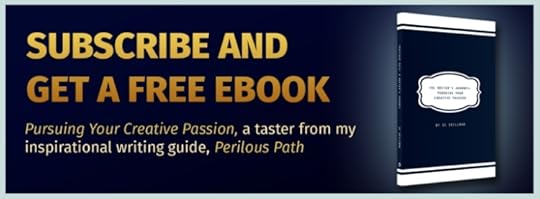
Do sign up to my mailing list here. I’d love you to join me on my writing and publishing journey! I share gems and snippets from my research discoveries, along with news and insights from the writing and publishing worlds. Also you’ll be the first to hear when I have a new book coming out.
And for those regular readers of my articles and posts here who’d like to support me on my writing journey you can do so here at buy me a coffee. I’d be very grateful!
February 20, 2023
Strange Tales From Paranormal Warwickshire part 1: Warwick Castle
Today, I begin the first episode in a series of strange tales from my book Paranormal Warwickshire.
 Guy’s Tower, Warwick Castle (photo credit SC Skillman)
Guy’s Tower, Warwick Castle (photo credit SC Skillman)Warwick Castle is, of course, the first thing many people think of when Warwick comes to mind. And no wonder: when I researched for my forthcoming book ‘A-Z of Warwick‘ (due out in November 2023 and now on pre-order) I was constantly reminded that very little happened during Warwick’s rich history that didn’t have an Earl behind it.
From the earliest Norman earl, through to Richard Beauchamp (who commissioned the Beauchamp Chapel), and on to Richard Neville the Kingmaker, and later Ambrose Dudley (Sir Robert’s brother), and finally the extravagant Grevilles who magnificently improved the castle then had to sell up under mountains of debt… everything of historical interest in Warwick was financed or set in motion or driven by one of the Earls.
I love them all because their complex personalities are at the heart of so many Warwick stories – funny, scandalous, astonishing, shocking, tragic, ridiculous, brutal, calculating, brilliant, monstrous, far-reaching.
Only recently I met someone who added another strange story to my fund of tales. A friend of his had encountered a disturbing presence whilst staying overnight in Caesar’s Tower: by the morning he was bruised, and felt strongly he was being pushed by an invisible presence. Caesar’s Tower has quite a reputation for paranormal activity; local investigators carry out overnight vigils there and on one occasion reported that ‘the activity was so intense’ they had to leave. The other major tower of the castle, Guy’s Tower, also has its curious tales. One of them is an inscription found on the wall of a forgotten cell, believed to be the work of Walt Disney’s ancestor Edward Disney, imprisoned there during the English Civil War. The fact that Edward was eventually reprieved, and not executed, is all to the good for those who are fond of Walt Disney’s achievements; for he wouldn’t have existed if Edward his forebear had met his demise at the castle.
Here I read from my Warwick Castle chapter in ‘Paranormal Warwickshire’.


Join my email list
By clicking submit, you agree to share your email address with the site owner and Mailchimp to receive marketing, updates, and other emails from the site owner. Use the unsubscribe link in those emails to opt out at any time.
And if you’re a regular reader of my blog posts and articles and would like to show your support for my writing you can do so here at buy me a coffee. I’d be very grateful!
View this post on InstagramA post shared by Sheila Robinson (@sheilarobinson700)
Strange Tales From Paranormal Warwickshire part 1
Today, I begin the first episode in a series of strange tales from my book Paranormal Warwickshire.
 Guy’s Tower, Warwick Castle (photo credit SC Skillman)
Guy’s Tower, Warwick Castle (photo credit SC Skillman)Warwick Castle is, of course, the first thing many people think of when Warwick comes to mind. And no wonder: when I researched for my forthcoming book ‘A-Z of Warwick‘ (due out in November 2023 and now on pre-order) I was constantly reminded that very little happened during Warwick’s rich history that didn’t have an Earl behind it.
From the earliest Norman earl, through to Richard Beauchamp (who commissioned the Beauchamp Chapel), and on to Richard Neville the Kingmaker, and later Ambrose Dudley (Sir Robert’s brother), and finally the extravagant Grevilles who magnificently improved the castle then had to sell up under mountains of debt… everything of historical interest in Warwick was financed or set in motion or driven by one of the Earls.
I love them all because their complex personalities are at the heart of so many Warwick stories – funny, scandalous, astonishing, shocking, tragic, ridiculous, brutal, calculating, brilliant, monstrous, far-reaching.
Only recently I met someone who added another strange story to my fund of tales. A friend of his had encountered a disturbing presence whilst staying overnight in Caesar’s Tower: by the morning he was bruised, and felt strongly he was being pushed by an invisible presence. Caesar’s Tower has quite a reputation for paranormal activity; local investigators carry out overnight vigils there and on one occasion reported that ‘the activity was so intense’ they had to leave. The other major tower of the castle, Guy’s Tower, also has its curious tales. One of them is an inscription found on the wall of a forgotten cell, believed to be the work of Walt Disney’s ancestor Edward Disney, imprisoned there during the English Civil War. The fact that Edward was eventually reprieved, and not executed, is all to the good for those who are fond of Walt Disney’s achievements; for he wouldn’t have existed if Edward his forebear had met his demise at the castle.
Here I read from my Warwick Castle chapter in ‘Paranormal Warwickshire’.


Join my email list
By clicking submit, you agree to share your email address with the site owner and Mailchimp to receive marketing, updates, and other emails from the site owner. Use the unsubscribe link in those emails to opt out at any time.
And if you’re a regular reader of my blog posts and articles and would like to show your support for my writing you can do so here at buy me a coffee. I’d be very grateful!
View this post on InstagramA post shared by Sheila Robinson (@sheilarobinson700)
February 13, 2023
Book Review: ‘The Salt Path’ by Raynor Winn
I have come at last to read The Salt Path by Raynor Winn, having heard much about it. I usually hesitate to read much-hyped books, but now, finding it on the shelves in Warwick Books, I’ve given in on this one! The first thing to say is that the cover design artwork for this book, and for its two follow-ups, is exquisite and may play a large part in their success.
‘The Salt Path’ is, I’ve discovered, one of those books for which the one-star reviews on Amazon are almost more revealing and fascinating than the book itself. For those who would like insights into how the residents and the coastal business-owners of Cornwall and Devon feel, this book and its most critical reviews are worth reading!

Personally, I found it a gripping read; and as a nonfiction writer myself, I know that’s no mean feat.
I’ll start by saying that although I’ve walked tiny bits of the South West Coastal Path, and used to go on 50 mile sponsored walks from my local area, and have climbed mountains in the Lake District, and Snowdon in Wales, I’ve never attempted such a walk as the one described in this book, and at this stage don’t believe I ever would (unless forced to!)
Given their recent devastating life events, the psychological turmoil Raynor and Moth carried with them on the journey is highly relatable, and many of us would have felt that way ourselves, when life turns bad, and frustration, loss and perceived injustice comes our way. It was clear to me that the arduous walk she and Moth undertook along a glorious but challenging coastline would have ultimately burned away those negative emotions. It is also an extraordinary claim that this demanding walk reversed the symptoms of Moth’s Corticobasal degeneration, a terminal degenerative neurological disease with a maximum survival rate of 6-8 years from first appearance of symptoms.
I approached this book as one who enjoys picaresque tales of people ‘on the edge’ going wild and living on their wits. Raynor and Moth begin their journey at Minehead, and by the time the narrative gets them to Newquay (on page 135), I feel they have served their preparation ordeal, passing through all the self-pity, anger, resentment, and physical deprivation their situation throws up. Raynor is very honest as she portrays their discomfort, mistakes, and humiliation, as they resort on a couple of occasions to thieving, survive on a poor and inadequate diet, and somehow resist the temptation to give up. They push through the threshold magnitude of endurance, to reach a fresh resolve, to glimpse a possible new way of being, and to let go of the psychological blocks that so often define our lives, and prevent us from living fully.
Raynor describes several encounters throughout their journey with people who react to them in a variety of ways. Some, upon questioning the couple, see Raynor and Moth as being lucky and free. And along the path, the pair do on occasions meet with amazing generosity, and acts of kindness. I love the ‘Cornish sages and prophets’ they encounter, including the casual labourers / surfers living in the barn, who, instead of judging them, compare their situation to a “fetch”, a term known to surfers. These insights would have been so uplifting to them, and would have sustained them when their journey was over.
The story did remind me a little of another book I read a few years ago, set in New South Wales, called Out of the Forest, by Gregory Smith, in which the narrator described his experiences living wild in the forest for years. He later returned to society, completed his education, and ultimately became a Professor of Sociology in a nearby University. In our culture today, some individuals can live wild, or in circumstances of privation and endurance on the edge of society for a while. With a mixture of survivalist skills, luck, determination and living on your wits, you can get away with it for a period of time. But you cannot live like that long-term. Eventually, those who try this way of life can’t stand it any more, and find their lives depend upon the benefits of civilisation, which they have to re-enter.
By the time they have arrived at Lizard Point, Raynor seems also to have reached a place of calm acceptance and to have shed the worst of her bitterness, self-pity, anger and resentment. They stop at Polruan then take up an opportunity to spend all winter at her friend Polly’s Midlands sheep farm, renovating and living in a farm shed, and working on the farm. Warm weather again finds them at Poole, ready to walk the 250 miles back to Polruan.
At Talland Bay, breakthrough comes, the moment of transformation. They meet a lady called Anna at a café. Anna offers them her flat to rent in Polruan, not far from the university at Portsmouth where Moth has decided to sign up as a mature student. We have a feeling they are saved at last, and as Raynor points out, they end up living where their path ends. I do like the outcome to their journey, and ultimately feel uplifted by this unusual travel diary.


Join me on my journey and sign up for my monthly newsletter straight to your inbox. I share snippets and gems from my research discoveries, and news and insights form the publishing and writing worlds. Also you’ll be the first to hear when I have a new book coming out.
Also, if you’re a regular reader of my blog posts and articles and would like to show your support for me as a writer, you can do so here on buy me a coffee. I’d be very grteful!
February 7, 2023
Book Review: ‘The Spirit Engineer’ by AJ West
The Spirit Engineer by AJ West: This fictionalisation of a true story was probably one of the creepiest tales I’ve ever read.
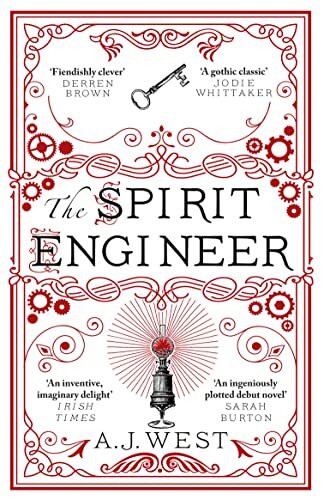
The Spirit Engineer by AJ West was published in July 2022.
Its creepiness does not come from the purported spirits conjured up by the deceptive Goligher family in 1920s Belfast, but much more from its portrayal of perverse behaviour by the living, specifically the spiritualists of the time. Why they ever thought their theatrical activities in near darkness would ever give any bereaved person any comfort at all will mystify the contemporary reader.
But the story is set in the context of a society still reeling from massive loss, following the sinking of the Titanic, and the horrors of the First World War. The modern reader may wonder how the bereaved could ever have imagined that so-called “spirits” might be likely to behave in this way. Grief and despair, however, would have driven those who attended the seances to discount the ludicrous, and cling on to any opportunity for some sort of communication with their departed loved ones.
The Spirit Engineer by AJ West is well researched and this is attested to by the plentiful information on the author’s website.
To my mind, the most disturbing thing of all about this novel is the increasingly deranged mental state of Dr William Crawford himself, a highly accomplished engineer and academic, who penned three books about his investigations of the Goligher Circle. With their equipment, tricks and subterfuge, the members of the Circle – and specifically Kathleen, their talented 16 year old medium – somehow managed to fool him for three years, without it occurring to him to actually shine some light on the subject (literally).
Within this story, the Golighers are portrayed as having some sort of vendetta against Crawford: they appear to be persecuting him personally. He is tormented by these spiritualists, who have gained information about his relationships and situation. This information, of course, he and the other believers attribute to the spirits themselves. The ingenious plot twist at the end turns that perception on its head in the most shocking way. It still doesn’t change the fact of the highly unsavoury, manipulative behaviour of the Golighers and other spiritualists like them.
Crawford’s own character, as portrayed in the novel, is highly flawed from the start: he comes across as childish, emotional, and intemperate. He bullies his family members and is rough and abrasive with anyone he considers of inferior social status. Despite this, his academic superiors clearly admire him on a professional level. He strikes the reader as a brilliant engineer, theoretically, but on a personal level, extremely immature.
He starts to get caught up in the fervour of contacting the dead. He’s drawn in by his wife Elizabeth, following the tragic loss of her brother Arthur on the Titanic, and their most recent loss of five year old Robert, in circumstances for which Crawford must take partial blame, and which torment him with guilt. At the centre of the Goligher Circle, apparently offering comfort and consolation, we find 16 year old Kathleen, their star medium.
I began to see a similarity between this story and that of Arthur Miller’s play ‘The Crucible’, where primitive emotions stirred up by young girls lead those around them to believe in supernatural danger. However, there is another way of seeing this phenomenon, which is fully outlined in the author’s research notes on his website. For young girls in many patriarchal societies, spiritualism offered their one opportunity for ‘agency.’ A young girl usually featured at the centre of this: the only way she saw to gather attention, status and some sort of power in her life.
In addition to his other failings, the fictional Crawford is presented as an irascible, short-tempered man; abusive and curt to those he looks down upon. The seances he investigates are violent, with a lot of histrionics, screaming, and high emotions.
It seems, however, that this man, no matter how accomplished as a scientist, is now in the grip of a delusion, which grows ever stronger as the story progresses. His obsession reaches the level of a frenzy. He displays sadistic, controlling behaviour, especially to women. It astonished me that the women of the Circle, not least his assistant Rose, and the medium Kathleen, consented to be so physically abused: but of course Crawford himself wrote three highly successful books about his investigations of this group, purporting to prove the existence of the afterlife, which proved irresistible to a large audience of readers and netted him a fortune. During his investigation, the Golighers would have benefited financially too.
My overall impression of this novel is that of a highly dramatic account of one man’s descent into madness. The story does offer a sobering reflection upon human gullibility, not least that of another brilliant man, Sir Arthur Conan Doyle, who appears in the story. I have occasionally reflected on the irony of Conan Doyle’s belief in spiritualism despite his own genius in creating such a well-loved character, Sherlock Holmes, renowned for his superlative intellect and a scrupulous and questioning mind.
Alongside this, we have the counterinfluence of the magician and escapologist Harry Houdini, who demonstrates to both Conan Doyle and to Crawford how he can easily replicate the effects produced by the spiritualists. Unfortunately his efforts do not convince Crawford, which shows the fatal weakness of human nature, enabling some of us to hold on to what we most want to believe in, despite all evidence to the contrary.
An electrifying read.


Join me on my journey and sign up to receive my monthly newsletter straight to your inbox. In this I share snippets and gems from my research discoveries, and news and insights into the publishing and writing worlds. Also you’ll be the first to hear when I have a new book coming out.
Also if you’re a regular reader of my blog posts and articles and would like to support me as a writer, you can do so here at buy me a coffee. I’d be very grateful!
January 30, 2023
Book Review: ‘The Winter Guest’ by W.C. Ryan
I was engrossed by this historical novel set in Ireland in 1921 among The Troubles that exploded in 1919 in the Irish War of Independence after the First World War.
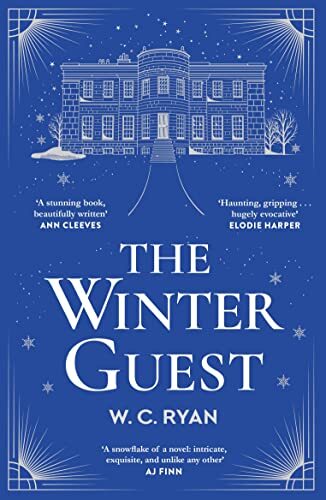
The Winter Guest by W.C. Ryan brings our investigator and first person narrator Tom Harkin to the atmospheric, crumbling and haunted ancestral mansion of the Prendeville family, close beside the sea, to unravel the mystery behind the murder of his former fiancée, Maud Prendeville.
Some reviewers have noted its ‘moody, gothic atmosphere’ and its ‘bracing whiff of the supernatural.’ Several years ago I attended a talk by a top literary agent and he remarked that setting and topics go in and out of fashion in the publishing world, especially those connected to political events; and at that time, he said any novel set against the Irish troubles would be rejected, because ‘everyone’s fed up with the Irish troubles right now and they don’t want to read fiction about it’.
Interestingly, here in 2023, the Irish troubles are an OK setting again, especially as the events this novel describes are set over a hundred years ago. And certainly this author opened up for me all the passionate convictions of the IRA Column and Volunteers, in their struggle against Britain, represented by the Royal Irish Constabulary and the ‘Auxies’ as they were called (Auxiliaries).
For a contemporary reader, or at least, for me, I spent the first part of the novel confused about who was on whose side and who was against Britain and who was fighting for independence, and who would be highly motivated to kill or to defend who. This was a lot to do with the labels they gave themselves. Some of the characters were double agents, and were pretending to side with those in authority, when really their hearts and souls were with the cause of independence.
Once I’d sorted all that out in my mind, I was able to fully engage with this story of Tom Harkin, just back from the traumatic conflict of the First World War, ostensibly an insurance assessor but really an IRA Intelligence Officer. Tom has travelled from Dublin to the gloomy coastal Kolcolgan House to investigate the murder of his former fiancée, the lovely Maud Prendeville, in an IRA ambush. Initially I found the whole thing as confusing as the fictional characters. Why was Maud, who had shown herself a fighter for independence, been gunned down by her own side?
If Tom had not persisted in his investigations, Maud’ death would have remained an unresolved mystery, just another accidental killing or example of collateral damage. But Tom is untiring in his quest for the truth among the aristocratic Prendeville family and all their ghosts and living associates, and he uncovers a network of complicated and nefarious underhand activity, implicating Maud’s closest Prendeville relatives, who hold a high status in society and have strong connections with the powers that be. The story gathers in intensity and intrigue, and I became swept up in the progression of events, the rising tension, and the multiple shocks that accompany Tom’s discoveries.
In the end this proved to be an absorbing and compelling novel, thought-provoking in its subject matter and ingenious in its plotting.


Join me on my journey and sign up to receive my monthly newsletter direct to your inbox. I share snippets and gems from my research discoveries, and insights from the world of publishing and writing. Also you’ll be the first to hear when I have a new book coming out.
And if you’re a regular reader of my blog pots and would like to support me on my writing journey, you can do so at Buy Me a Coffee and I’d be very grateful.
January 25, 2023
The Lure of a Country House Library
I was inspired by an Instagram post I read recently from a fellow-author.
She said she was warming up with a cup of coffee at the Dorchester Curiosity Centre in Dorset, while waiting for her MOT to be done, and ‘contemplating how cover design has developed over the decades’. She was looking at an entire wall filled with enticing covers of books over the past fifty years.
So, I replied, “Oh for the days when a book cover was boring, and you had to open a book to find out what it was about!”
 The library bookshelves in Upton House, Warwickshire (National Trust)
The library bookshelves in Upton House, Warwickshire (National Trust)I was thinking about all those beautiful libraries history lovers enter, within grand country homes open to the public gaze. They are my favourite rooms in the house. Usually there is a vast antique desk in a warm golden oak, with crystal ink pots and the finest stationery sets laid out upon its green baize cover. Elsewhere upon its gleaming timber surface we may notice a pure silver tray, and upon this reposes a cut glass decanter of port, sherry or madeira wine, and a few elegantly arranged crystal glasses, and perhaps a dish of almonds and delicate cheese portions. Behind the desk we may find a luxurious leather throne.
Elsewhere we may sink into sumptuous leather armchairs, or Chippendale chairs, and the finest oak tables to place our books on. The walls are lined by deep carved oak shelves, from floor to ceiling, filled with a glorious display of books all mysteriously bound in the same restrained russet or midnight-blue or bottle-green with gold tooled titles on the spine. To decide on a book, you had to go through the shelves and take one out and open it and scan the title page inside and the first few paragraphs and decide what you think.
I later discovered that the book cover as a way of advertising a book’s contents did not exist until the late 19th century. Until then, book bindings – made in leather or vellum – were merely handcrafted protection for expensively printed or handwritten pages.
 The library in Charlecote House, Warwickshire (National Trust)
The library in Charlecote House, Warwickshire (National Trust)There was none of this ‘being-hit-in-the-face’ as we are these days as we enter a bookshop, and soon become dizzy with multiple colours, stunning designs and sensory overload. No kaleidoscopes of images from every sphere of human existence, designed to hook you and claim your attention, with the purpose of gaining access to your inmost desires in the shortest time possible, to chime bells inside you, to meet whatever needs you believe you may have. How do the people with synaesthesia cope, I wonder? Those who hear colours as sounds, or experience sounds as colours?
But back before the late 1800s, no-one expected this when they entered a realm of books. Nothing would break in on them. These were times of leisure and contemplation and deliberation, we might think, if we enter one of the gracious libraries in an English stately home.
How I long for the mental and physical space, silence, and peace that I imagine reigned within some of those libraries. My dearest wish would be to go on retreat there for several days or even weeks, with all my needs catered to of course, several of them being met by on-call, willing and ever attentive uniformed staff. (The others might be catered to by a visit to the nearby bathroom with its gold taps and blue and white Delft tiles upon the walls and its porcelain fittings). I would then calmly enter into the world’s greatest literature, spending quality time with the hearts and souls of those who penned it, their wisdom, their insights, their profound thoughts enshrined within the most beautiful language and powers of self-expression. I would have time to imbibe all this, and to take it all into my own heart and soul.
 Stoneleigh Abbey, Warwickshire, viewed from the other side of the river – photo included in Paranormal Warwickshire by SC Skillman pub. Amberley (photo credit: SC Skillman)
Stoneleigh Abbey, Warwickshire, viewed from the other side of the river – photo included in Paranormal Warwickshire by SC Skillman pub. Amberley (photo credit: SC Skillman)A dream, you say? An idyll that never existed? Or a luxury only for the privileged few in a profoundly unjust world? For all those who dwelt in this environment during those days when the house was a live space, not merely a museum, would have had their own sorrows and anxieties and pressures too. They too, like us, would have been plagued by annoying people. The staff would probably have brought their own personal troubles into the house. The world they all lived in was replete with dreadful tragedies, social injustice, natural and man-man disasters, and political folly all borne from and fed by the same greed and lust for power that surrounds us all today. They themselves, as individuals, may have been protected from that world to a certain extent by their money: even that did not save them from the effects of disease both physical and mental, ignorant doctors, bereavement, war, broken relationships, adultery and child mortality.
Yes, yes, I recognise all this: but back to those beautiful libraries. Surely, they were created by people with a vision: a vision for what life COULD be like, a vision for what many of certain tastes, like me, dream of and value. A vision marred, of course, by human nature and social injustice, and the fact that humans cannot seem to bring anything into reality, however dreamlike, that does not eventually become elitist, and connected with material wealth and social status. A beautiful, mellow, golden room, lined with books.
 Chandos Leigh, poet, 1st Baron Leigh of the second creation, painting in Stoneleigh Abbey, Warwickshire
Chandos Leigh, poet, 1st Baron Leigh of the second creation, painting in Stoneleigh Abbey, Warwickshire(from Paranormal Warwickshire by SC Skillman pub. Amberley)
My favourites, all from grand country houses in the county of Warwickshire where I live, include the libraries at Charlecote House, Stoneleigh Abbey and Upton House. At Charlecote, the Lucy family were the lucky owners of the library. At Stoneleigh Abbey, Chandos Leigh, romantic poet and contemporary of Lord Byron, spent his happiest hours here within this room, and probably still haunts it today. At Upton House, Lord and Lady Bearsted enjoyed the warmth of this room.
We can dream, and then we return to the twenty-first century high street bookshop and synaesthesia-challenging covers.


Join me on my journey and sign up to receive my monthly newsletter in which I share snippets and gems from my research, and new of the writing and publishing journey Plus you’ll be the first to know when I have a new book coming out.
Also, if you’re a regular reader of my blog posts and would like to support me on my writing journey, you can do so at Buy Me a Coffee and I’d be very grateful.
January 16, 2023
Book Review ‘The Shadowing’ by Rhiannon Ward
Today, I’m pleased to share with you my review of another of my Christmas book gifts: a gothic novel published in 2021 by Orion Books.
The Shadowing by Rhiannon Ward is both a captivating read and a learning experience.
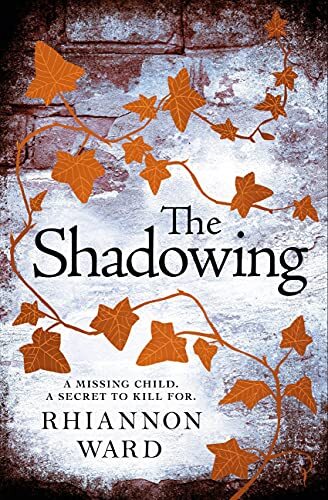
I read this book in one evening and it gripped me throughout. Variously described on Amazon as Gothic Romance / Historical Fantasy / Metaphysical and Visionary Fiction, this novel is set in the 1840s and opens up to us the life of Southwell Workhouse, Nottingham (now in the ownership of the National Trust), of Quakers and Primitive Methodists and how society viewed them at that time, the system of coach travel just before the railways took over, and also the horror of Victorian baby farming.
Hester, the main protagonist, from a Bristol-based Quaker family, has a tyrannical father, a weak mother, and a very loyal, sympathetic maid, Susanna. Hester combines her strong, determined and steely character with outstanding psychic gifts, intensely aware of “the spirits”, especially her dead sister, Mercy, whose mysterious death at the Southwell Workhouse she sets out to investigate.
I learned so many things from this novel. I had previously been aware that the authorities felt threatened by the Quaker movement when it first arose, and I knew early Quakers were imprisoned and treated like criminals, but I hadn’t realised the deep suspicion and distrust with which the ordinary people viewed Quakers and Primitive Methodists even after the practice of their religion had become legal.
The fact that Hester is a Quaker is recognisable by her plain clothing. I wasn’t at first sure why she needed to hide her “shadowings” (spirit sightings) from her father Amos, and also was mystified why her mother Ruth would feel obliged to tell him, if she knew. It intrigued me to discover that some Quakers at that time were quite fanatic and as bad as the most extreme Puritans and members of the Brethren sects – I had always thought the hallmark of Quakerism was tolerance and open-mindedness. This was a revelation to me.
The story begins with the arrival of a formal death notification from the superintendent of the Southwell Workhouse, addressed to Hester’s father. Hester’s sister Mercy, who ran away from home three years ago, has died at the Workhouse.
It then becomes Hester’s task to set off from Bristol to Southwell, and unravel the mystery.
The author’s description of travel by coach before the first railways began to be built in England was vividly described and answered many questions to which I had previously not known the answer. The novel gave me a very good feel for what it would have been like, in all its details, especially for a woman travelling alone.
Hester first arrives at the local coaching inn, run by Matthew, and spends a considerable time there awaiting her hosts, Dorothea and daughter Caroline, who are also Quakers but much more liberal. Matthew is going to play a significant role in this story, though Hester doesn’t know that yet. Finally, her hosts arrive and take her to their home – they are clearly well-to-do and ‘worldly’, a term used several times in this novel in a positive sense, meaning realistic and open-minded.
Hester pursues the mystery surrounding Mercy’s death, and the question of why she didn’t marry the man she eloped with, Mr Philips; why she never returned to her family nor did she, apparently, ever contact them; why she instead turned up at the Southwell Workhouse; why and how she died, and why she didn’t tell the Workhouse authorities that she was a Friend, or Quaker (which would have entitled her to different burial arrangements).
When Hester travels to visit the workhouse, we discover the local people view it with fear and horror; and once inside she learns that pregnant women are put in the dormitories for the “undeserving poor” and “given extra religious instruction” (meaning, as we would now describe it, ‘moralised at’ and ‘psychologically abused’). The more she learns about the system at the workhouse, the more shameful it becomes, exposing a system of callousness, cruelty and inhuman exploitation. Later Hester meets the local parson, and we discover he’s a nasty piece of work as well.
Throughout the story, the feeling of ghostly presences hovering around Hester is very strong, giving urgency to her mission.
The outcome of the story is both surprising and shocking, totally reversing our previous view of quite a few characters; and it will certainly have you doing your own online research about many aspects of mid nineteenth century England.


Why not join me on my journey and sign up here for my monthly newsletter straight to your inbox. In this I share snippets and gems from my research discoveries, and insights into the world of publishing and writing. You’ll also be the first to know when I have a new book coming out. Also if you’re a regular reader of my blog and would like to support me on my writing journey, you can do so here at BuyMeaCoffee and I’d be very grateful.
January 9, 2023
Book Review: ‘Madam’ by Phoebe Wynne
This gothic novel Madam by Phoebe Wynne held me captive throughout, despite some reservations about the plot and development of ideas.
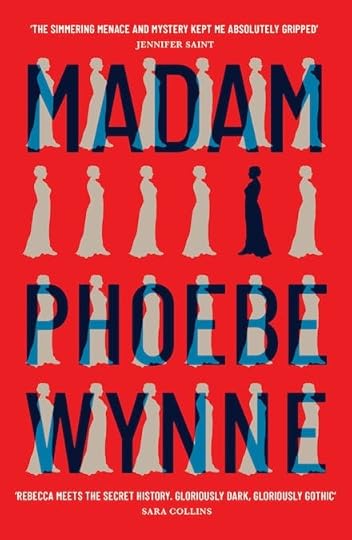
The author builds a strong feeling of creepy, sinister, weird claustrophobia in an exclusive independent girls’ school on the Scottish coast. The main protagonist, Rose, has just been appointed to the highly paid post of Head of Classics in this school for the daughters of wealthy, aristocratic, privileged parents, housed in a remote castle. She has doubts about the job before she accepts it; but the school will take care of her elderly invalid mother and this commitment is linked to Rose’s appointment to the school.
However, once there, despite building a special rapport with some of her pupils, Rose begins to feel oppressed by many things including the odd insistence on calling all the female teachers ‘Madam’, and the lies and false accusations directed against her. The reader is conscious of a sense of powerlessness, of being pushed to the edge of paranoia, of being restrained, of secrets closely guarded, information withheld, and strings drawn tight around Rose. I began to see parallels with certain aspects of Picnic at Hanging Rock, and Lord of the Flies, as Rose is stalked by a deeply disturbed girl, Bethany.
Questions are sewn in the reader’s mind. What happened to Rose’s predecessor, Jane, who was dismissed for some undisclosed reason? What is wrong with Bethany? What was the nature of her relationship with Jane? What exactly is going on at the school? Why is it all so weird? We are troubled by the realisation that the school’s control of Rose is closing in on her and her life.
Throughout the story we are introduced to various key female figures in Ancient Rome and Ancient Greece: both from history and from mythology. I enjoyed this, though intrigued by why some of these women should be regarded as inspirational, since many ended up committing suicide or being killed or having their fates determined by men. I studied Classical Background at university and have read translations of the Greek tragedies, Homer and Virgil, and Suetonius: The Twelve Caesars with relish and fascination. I have certainly never thought of Nero’s mother Agrippina as a heroine of feminism, though I must admit she was strong, determined and wilful!
Soon we recognise the paradox that although the school supposedly has a superlative educational reputation, the girls are not being taught academic excellence at all. That does not seem to be the goal. The standard of teaching prior to Rose’s arrival, the girls’ level of knowledge, and quality of concentration and application, is extremely poor. What’s going on?
The headmaster is a mystery and seems to hold off from a proper meeting with Rose for quite a long time. Later he becomes menacing and directly threatening. Rose realises she is trapped here: her life and integrity are constrained. She is fully locked in; coercion and blackmail are frequently used tools. Rose’s only realistic option is total conformity to the evil system.
The whole idea, we learn, is to keep women subservient for ever. The sheer corruption of this place is overwhelming: everything is directed to strengthening the power and ultimate control of those with wealth and high status in society – who are of course male – and this triumphs over ethics, social justice, personal freedom and respect for human rights. This even trumps any respect for the national academic league tables. Finally, it is very clear that Rose’s mother, is being held hostage.
I was captivated as I read this story but there were a number of flaws. First, the book is unnecessarily long, and several scenes are over-written. I felt it would have benefited from tight editing. Particularly towards the horrific end, the writing became loose, repetitive and drawn out.
There were also a number of anomalies; and set as it was in the 1990s, I wondered how such a plot really would succeed in our society. Nevertheless, this picture of a wicked attempt to reverse everything that has been so hard-won by the feminist movement, was very thought-provoking.
Despite the caveats, for its atmosphere, tension and fascinating ideas, I applaud this debut novel by Phoebe Wynne.


Why not join me on my journey and sign up to receive my monthly newsletter direct to your inbox? Also, if you are regular reader of my articles and book reviews here on this blog, I’d be delighted if you’d like to support me on buymeacoffee.
January 2, 2023
Book Review: ‘Down Under: Travels from a Sunburned Country’ by Bill Bryson

Today I’m pleased to share with you my review of one of my Christmas present books. Having visited several of the Australian locations in this book – Sydney, Canberra, Alice Springs, Uluru, Darwin, and the Great Barrier Reef, among several others – I loved reading about Bill Bryson’s experiences there in his brilliant piece of travel writing, Down Under.
Bill Bryson is the most engaging non-fiction writer: I was captivated by his mix of whimsical observations, self-deprecating anecdotes, hilarious remarks about the foibles of his travelling companion, and reports on overheard conversations. These are interspersed with occasional excursions into the history, geography, politics or scientific facts and curiosities about particular places. What I enjoy most is the feeling he gives the reader of moving in close to a subject, examining its quirkiest or most singular aspect, then panning out again to take a more distant or panoramic view.
 Bill Bryson, travel writer
Bill Bryson, travel writerHe reserves his funniest writing for those occasions when he encounters total frustration and annoyance. I don’t think I will ever again be on my travels, up against an infuriating person, circumstance or chain of events, without wondering what Bill Bryson would make of this. He is at his best as a writer when things go wrong. Those of us who are non-fiction writers can all take heart from this. He gives a totally new complexion to the concept of ‘hard luck’, ‘missing out’, or ‘arriving too late’.
I think my favourite episode in the whole book is when Bill and his increasingly tetchy companion drive around Darwin several times trying to find a hotel whose name is unaccountably different from the name it went by when he booked it. When he finally arrives in the reception of the hotel he has now driven past several times, disgruntled and fractious, the receptionist makes it quite clear she has never heard the saying ‘the customer is always right’. Bill Bryson’s assessment of her, the hotel, and the people of Darwin would not look good on Trip Adviser. When I later checked this hotel out, I discovered that several travellers had indeed given it a very low star rating with a mixture of scornful comments.
Those who read Bill Bryson’s travel books must end up in two minds about whether or not they would like to be his travelling companion for one of his journeys: or indeed, one of the people he meets, chats with, or whose conversations he overhears and records. From my experience, people rarely recognise themselves in books, and of course, the author can always change the names. Would it be fun to agree to accompany Bill, or a decision they will never live down? I will now read Bill Bryson’s other travel books and continue to find great inspiration as a non-fiction writer.


Sign up here to join me on my journey. I share snippets and images from my research discoveries plus news and insights from the writing and publishing worlds. Also you’ll be the first to hear when I have a new book coming out!
And if you’re a regular reader of these posts and my works, I’d be delighted if you’d like to support me on buymeacoffee
Thank you!



